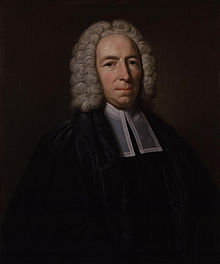- Conyers Middleton
-
Conyers Middleton (December 27, 1683 – July 28, 1750) was an English clergyman.
Middleton was born at Richmond in Yorkshire, and was educated at school in York and at Trinity College, Cambridge.[1] He graduated from the University of Cambridge, took holy orders, and in 1706 obtained a fellowship, which he resigned upon entering into an advantageous marriage. In 1717, he became involved in a dispute with Richard Bentley over the awarding of degrees. He wrote several trenchant pamphlets, among them the" Remarks" and "Further Remarks" on Bentley's Proposals for a New Edition of the Greek Testament, in which the latter tried to make his own case from the text of the New Testament.
In 1723 Middleton was involved in a lawsuit against Bentley, resulting from his tract on library administration, written on the occasion of his appointment as university librarian. In 1726 he offended the medical profession with a dissertation contending that the healing art among the ancients was exercised only by slaves or freedmen. Between the dates of these publications he visited Italy, and made certain observations on the pagan origin of church ceremonies and beliefs which he subsequently published in his Letter from Rome, showing an Exact Conformity between Popery and Paganism (1729). This tract probably contributed to the controversy which broke out against him on his next publication (1731).
Middleton had remonstrated with Daniel Waterland when the latter replied to Matthew Tindal's Christianity as Old as the Creation. Middleton took a line which in exposed him to the reproach of infidelity. In professing to indicate a short and easy method of confuting Tindal, he laid emphasis on the indispensableness of Christianity as a mainstay of social order. This brought him into conflict with those who held the same views as Waterland. Middleton was attacked from many quarters, and produced several apologetic pamphlets.
His next important publication was a Life of Cicero (1741), largely told in the latter's own words. Although Middleton's reputation was enhanced by this work, there is no doubt that he drew largely from a rare book by William Bellenden, De tribus luminibus Romanorum. The work was undertaken at the request of John Hervey, 2nd Baron Hervey; from their correspondence came the idea for The Roman Senate, published in 1747.
The same year and the following produced the most important of all his writings, the Introductory Discourse and the Free Inquiry "concerning the miraculous powers which are supposed to have subsisted in the church from the earliest ages." In combating this belief, Middleton indirectly established two important propositions. He showed that ecclesiastical miracles must be accepted or rejected in the mass; and he distinguished between the authority due to the early fathers' testimony to the beliefs and practices of their times, and their very slender credibility as witnesses to matters of fact. In 1750, he was driven to expose Bishop Sherlock's eccentric notions of antediluvian prophecy, which had been published 25 years before. Shortly afterwards he died, at Hildersham, near Cambridge.
Middleton's most ambitious work is out of date, but his controversial writings have a place in the history of opinion. Alexander Pope thought he and Nathaniel Hooke were the only prose writers of the day who deserved to be cited as authorities on the language. Samuel Parr, while exposing Middleton's plagiarisms, praised his style. An edition of his works, containing several posthumous tracts, but not including the Life of Cicero, appeared in 4 volumes in 1752 and in 5 volumes in 1755.
Works
- A Letter from Rome, Shewing an Exact Conformity Between Popery and Paganism, 1729
- A Free Inquiry into the Miraculous Powers, which are Supposed to Have Subsisted in the Christian Church, 1749
- Reflections on the variations, or inconsistencies, which are found among the four Evangelists (posthumous, 1752)
References
- ^ Middleton, Conyers in Venn, J. & J. A., Alumni Cantabrigienses, Cambridge University Press, 10 vols, 1922–1958.
- Sir Leslie Stephen, English Thought in the Eighteenth Century, ch. vi.
 This article incorporates text from a publication now in the public domain: Chisholm, Hugh, ed (1911). Encyclopædia Britannica (11th ed.). Cambridge University Press.
This article incorporates text from a publication now in the public domain: Chisholm, Hugh, ed (1911). Encyclopædia Britannica (11th ed.). Cambridge University Press.
Categories:- English theologians
- English clergy
- English Christians
- Christian theologians
- Christian writers
- English writers
- 1683 births
- 1750 deaths
- Cambridge University Librarians
- Fellows of Trinity College, Cambridge
Wikimedia Foundation. 2010.

